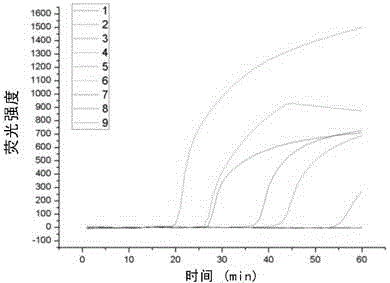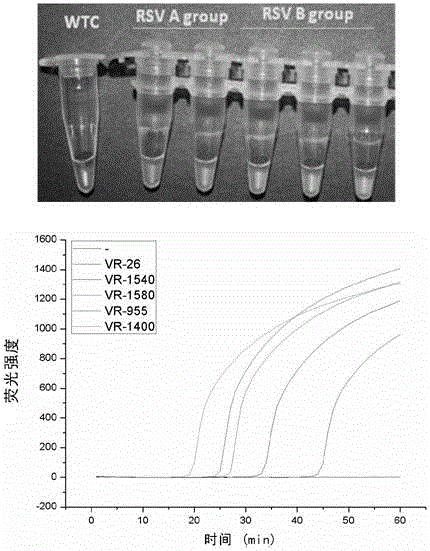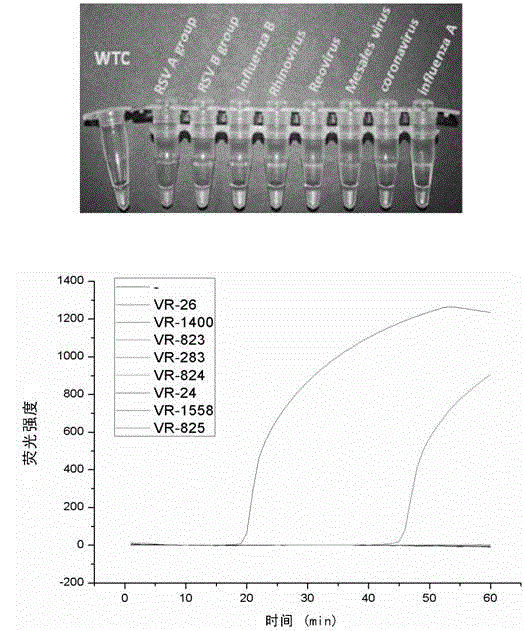Loop-mediated isothermal amplification based human respiratory syncytial virus detection kit
A loop-mediated isothermal, syncytial virus technology, applied in the fields of molecular biology and nucleic acid detection, can solve problems such as difficult color change result determination
- Summary
- Abstract
- Description
- Claims
- Application Information
AI Technical Summary
Problems solved by technology
Method used
Image
Examples
Embodiment 1
[0098] Embodiment 1, primer design
[0099] The whole genome sequence of 50 strains of HRSV (obtained from GenBank) was obtained, and multiple sequence alignment and sequence analysis were performed to find the conserved region. It was found that the difference between type A RSV and type B RSV was too large, and it was difficult to design general detection primers.
[0100] Further, for 50 strains of viruses, RSV type A and type B were separated and then compared, and it was found that type A was in the 1813-2030bp segment of the genome of the comparison result (ie: the 610-930th position of the N gene coding region of subtype A ), type B is highly conserved in the 12000-12600bp segment of the genome (namely: 2452-3052 in the coding region of the L gene of subtype B), which is suitable as a primer design region. For example, the 610-930th sequence of the coding region of the A subtype N gene includes any sequence of SEQ ID NO: 13-51; the 2452-3052nd sequence of the B subtype ...
Embodiment 2
[0115] Embodiment 2, system establishment and optimization
[0116] Taking the RT-LAMP system reported in the literature as the starting system (Ushio, M. and I. Yui, et al. (2005). J Med Virol77 (1): 121-7), the components are as follows:
[0117]
[0118] Three levels of memory orthogonal experiments were set up for the four factors in the above system.
[0119] Table 4. Factor level table
[0120]
[0121] Table 5. Table of experimental conditions
[0122]
[0123] RSV strains VR-1400 (type B) and VR-26 (type A) were used as templates to react with the designed primers and the combination of conditions listed in the experimental condition table, and the reaction process was monitored in real time with calcein.
[0124] The fluorescence quantitative detection results of the orthogonal experiment are as follows: figure 1 , the curve is the emission fluorescence of the reaction system in the range of 565-590nm over time, and the reaction curves 1-9 correspond to th...
Embodiment 3
[0131] Embodiment 3, visual and real-time monitoring of reaction process
[0132] Extract the RNA of RSV standard strains (A: VR-26, VR-1540; B: VR-1400, VR-955, VR-1580), use the mixed solution of RSV-A primer combination RSV-B primer set and so The extracted RNA was used as a template, and the following reaction system was used to react on a PCR instrument and a fluorescent quantitative PCR instrument to determine the effectiveness of the primer set.
[0133] Visual detection reaction system:
[0134]
[0135]
[0136] The reaction process is as follows:
[0137] Visual inspection was performed at 60°C for 60 minutes. The order of adding samples is shown in Table 7.
[0138] Table 7. Sampling order
[0139] 1
2
3
4
5
6
-
VR-26
VR-1540
VR-1580
VR-955
VR-1400
[0140] Fluorescence quantitative detection is:
[0141]
[0142] Fluorescence quantitative detection results such as figure 2 and Table 7. ...
PUM
 Login to View More
Login to View More Abstract
Description
Claims
Application Information
 Login to View More
Login to View More - R&D
- Intellectual Property
- Life Sciences
- Materials
- Tech Scout
- Unparalleled Data Quality
- Higher Quality Content
- 60% Fewer Hallucinations
Browse by: Latest US Patents, China's latest patents, Technical Efficacy Thesaurus, Application Domain, Technology Topic, Popular Technical Reports.
© 2025 PatSnap. All rights reserved.Legal|Privacy policy|Modern Slavery Act Transparency Statement|Sitemap|About US| Contact US: help@patsnap.com



